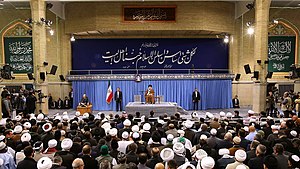

 | |
 Pictured here, the Imam Khomeini Hussainiya, part of the House of Leadership, is the place where the Supreme Leader usually meets the public.[1] | |
| Agency overview | |
|---|---|
| Formed | July 1989 |
| Preceding | |
| Headquarters | Tehran, Iran 35°41′31″N 51°23′55″E / 35.69194°N 51.39861°E / 35.69194; 51.39861 |
| Agency executives |
|
| Website | www.leader.ir |
The Office of the Supreme Leader of Iran (Persian: دفتر رهبر جمهوری اسلامی ایران, Daftar-e Magham-e Moazzam-e Rahbari lit. Office of the Supreme Leadership Authority), also known as the House of Leadership (Persian: بیت رهبری, Beit-e Rahbari), is the official residence, bureaucratic office and principal workplace of the Supreme Leader of Iran[5] since 1989.
Its structure is a mixture of traditional Beit (religious office of Marja') and bureaucracy.[6] The institution is located in central Tehran[7] and is run by Mohammad Mohammadi Golpayegani.[3]
The Office of the Supreme Leader is used by the Supreme Leader to communicate and administer orders to various other military, cultural, economic, and political organizations. A number of political, military, and religious advisors work under this office. These advisors have an influential role in decisions made throughout country.
According to Ali Motahari, a former member of parliament from Tehran, the influence of the Office of the Supreme Leader in the country's affairs are so great that "the parliament is effectively a branch of the Office of the Supreme Leader".[8]
On June 24, 2019, U.S. President Donald Trump signed Executive Order 13876, in which the assets of the Office of the Supreme Leader of Iran, along with Imam Ali Khamenei, are frozen following the incident near the Gulf of Oman in the days prior.[9][10]